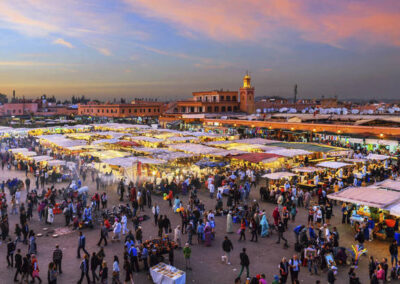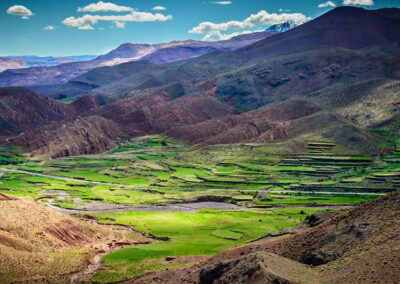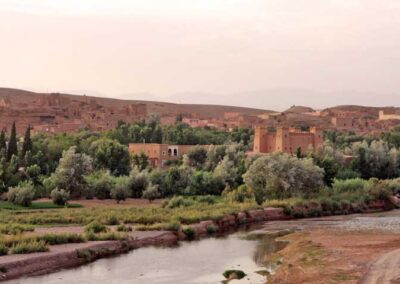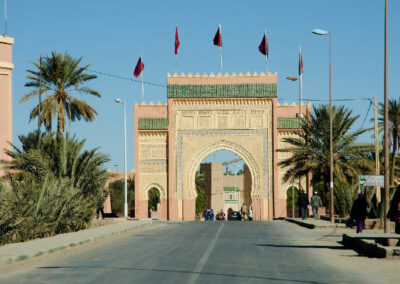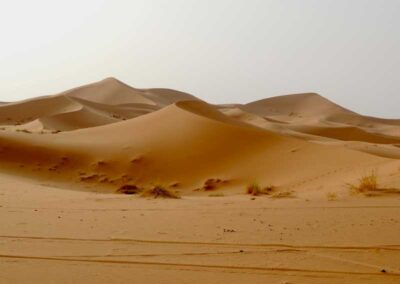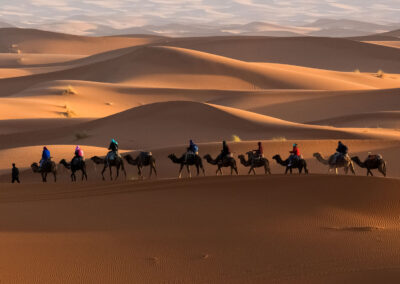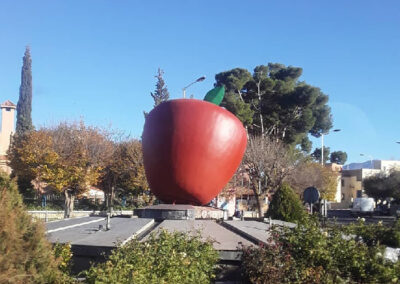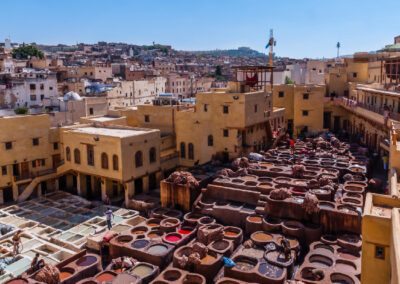Most essential places to visit in Marrakech & things to do during your stay
Marrakech, the Red City, is a walled city built in the 12th century. In this part of Morocco, the fortress walls are as red as the ground. For example, the high walls of the Medina. A veritable labyrinth, hiding many invisible wonders.
Treasures that reveal themselves from time to time through the vagaries of history, reconstruction, and the opening of cultural institutions, museums and guesthouses turned into riads. Let’s discover the medina’s most important places to visit in Marrakech and plan what we can do during our stay.
Enjoy a mint tea at sunset on the terrace overlooking Jemaa el-Fna Square. Get lost in the narrow alleys of the Souk. Stroll through the Majorelle Gardens. Stroll through the Koutoubiya Gardens, spending one night in a pasha and two nights in a riad. Stop at Medersa Ben Yousef, a historic building in Marrakech. Don’t miss a visit to the Bahia Palace. Know in depth the attractive places to visit in Marrakech through this article.
Travelling to the Medina in Marrakech
Things to do and visit in the Medina
The Medina of Marrakech is the largest in the Maghreb, at over 600 hectares, and is a UNESCO World Heritage Site. In the heart of Marrakech, the Medina welcomes tourists and humble Marrakechites. Its winding streets, fountains, courtyards and orange orchards make it a charming place to stroll. There’s also a constant street animation in the bazaar. The traditional houses of the medina have undergone extensive renovations in recent years. The riads have been converted into charming guesthouses, attracting tourists who want to experience the Orient.
Explore the Saadian Cemetery, Marrakech
Places to visit and what to do in the Saadian Cemetery, Medina
This garden in the Kasbah area is part of the El Mansour Mosque, which was renovated in the 16th century by the Saadins to house the tombs of their kings. Two mausoleums are on the site, separated by a small, beautiful garden. Then come in the morning as it gets very crowded…
Visit the Medersa ben Yousuf’ in Marrakech
What to see and do in Medersa Ben Youssef in the Medina
Medersa Ben Youssef is well worth a visit in the medina’s heart. This madrasa is actually a traditional Marrakech university, with a capacity for up to 900 students; it was built in the 16th century and is a masterpiece of Arab-Andalusian architecture. Floors, ceilings, plinths and columns. You won’t regret it! Everything is precious and exquisite.
Visit the Koutoubiya Minaret in Marrakech
What to do and see at the Koutoubia Minaret, Medina
Built in the 12th century, the Koutoubia minaret is modelled on the towers of the Hilarda in Seville and the Hassan in Rabat. When the Almohads conquered Marrakech in 1147, Abd el-Moumen ordered the construction of the Koutoubiya on the site of the Almoravid palace. The restored minarets now enhance their splendour, especially when illuminated at night. The Koutoubia is considered one of the most beautiful buildings in North Africa. It’s worth a visit and enjoys its impressive architecture.
Dar Said Museum, Marrakech
Things in the Dar Said Museum in Medina
This Moroccan art museum displays beautiful objects from the early 20th century, including wooden objects, jewellery, pottery, weapons, carpets, textiles, beautiful teapots with stands, trays and old musical instruments. These highlights can make you strongly want to visit this place in Marrakech.
A Visit to the Bahia Palace in Marrakech
Bahia Palace, Medina spots and things to do
Built around 1880, the Bahia Palace was the residence of Vizier Ba’Ahmed, who ruled Morocco from 1894 to 1900. A masterpiece of Moroccan architecture, the Bahia Palace is made up of houses with heterogeneous but magnificent decorations facing a flower-filled courtyard.
Jemaa el-Fna Square Tour, the most famous Square in Marrakech
What to see and do in the Jemaa el-Fna Square in the Medina
A permanent theatre, Jemaa el Fna Square is a fascinating place by day and by night. It is one of Marrakech’s liveliest neighbourhoods and, along with the Souk, is one of the city’s most popular tourist attractions. All walk around the medina start and end here, and after 5 pm, Jemaa el Fna becomes a bustling crowd. Snake charmers, fortune tellers, musicians and, in the evening, dozens of food stalls are on show to onlookers. The terraces of the nearby cafés offer a spectacular view of Jemaa el Fna Square, especially at dusk.
Marrakech, Souk strolls
Things you can do and will see in the Souk in the Medina
The market between Jemaa el Fna Square and Medersa Ben Youssef is one of Marrakech’s most fascinating attractions. Dye makers, basket makers, grannies… The seemingly random arrangement is particularly neat and photogenic. The city has established a tourist brigade, so it is best not to venture into the bazaar. There is just one danger. That is to fall in love with the wonders there. And be prepared to bargain. Because that’s the rule.
Marrakech, A visit to the Majorelle Gardens
Majorelle Gardens’ Highlights
A magnificent garden was created by painter Jacques Majorelle, who lived in Marrakech since 1924. The Majorelle Gardens were bought and restored by Yves Saint Laurent and Pierre Bergé in 1980. Cacti, bougainvillaea, bamboo and plants from the five continents. The Majorelle Gardens are colourful, lush and poetic. The artist’s studio is painted a bright lilac blue, known as the ‘blue Majorelle’, which contrasts with the colours of the plants. It is now a small museum.
There are other attractive places to visit in Marrakech, plan your tour with us and enjoy your stay in Marrakech. You will not be confused about what to do and see in Marrakech after now.
WHAT MAKES MARRAKECH A BEAUTIFUL TOURIST DESTINATION
Marrakech’s secret garden
How many times have we walked along this high wall on Moisson Street, one of the busiest streets in the medina, just outside the souk, past that high spiked gate that has been neglected since 1934? Imagine this wonderful secret garden just behind it, inherited from the 16th-century palace of the Saadian and remodelled many times by successive generations of influential people.
Remarkable restoration began in 2008. It was a bizarre idea, given the dilapidation of the building at the time. The construction period will last five years, two of which will be devoted to intensive work respecting architecture and traditional techniques.
When materials were in short supply, they were copied from those excavated in the area. An elaborate irrigation system consisting of pools, wells, open channels and underground pipes was discovered. Trees are brought in at night. In this densely populated medina, daylight is no match for cars!
In 2016, once only accessible to a lucky few, this place will finally be opened to the public. Exotic plants from all over the world adapted to Morocco, such as jacaranda from Central America, bottle tree from Australia and flamboyant from Madagascar, are fragrant all year round.
The second part is an Islamic garden with pomegranates, figs and date palms symbolising Allah’s Paradise, a classic and sacred planting of four flowerbeds separated by two crossroads. In the centre of the square is an elegant kiosk with a fountain.
The high tower (17 m), also called the Messun, overlooks everything, testifies to the power of the former owners and offers a magnificent panoramic view of the city. Marrakech’s hammams (traditional group baths), mosques and fountains owe their existence to these snow-capped mountains, whose waters have been collected and transmitted through a complex network of underground pipes called ketara since ancient times.
Dar Taswir, Dar Photography, the birthplace of photography
We are not discovering a secret place here, but a heritage long hidden in a drawer made known by the will of a few people who love the city. And what better way to witness Marrakech’s recent past than through photography, in 2009, Patrick Manac and Hamid Mergani took up exactly this challenge. And they succeeded thanks to the House of Photography.
They patiently collected more than 10,000 photographic documents from 1870 to 1960, including a valuable collection of colour autochromes from 1907, and donations from great photographers have further enriched this vast collection. In the form of photographs, postcards and glass plates, they all bear witness to Morocco’s past and traditions. These images, mostly in black and white, have found a place in this house with its solid walls and transparent curtains.
To ‘build a wall’ here is to stop time, align your gaze with yourself and enter a world of the past, where jellabas, turbans and sunlight cast incredible shadows. Another way to approach this mythical city is to revisit monuments we thought we knew in their former context. Look at the many portraits of people on street corners. Look at the detail of women’s jewellery and tattoos. Immerse yourself in scenes of life shot on location.
On the rooftop terrace, experience the present moment with one of the most beautiful views in the city. The sunset illuminates the space and the shadows stretch to infinity, which is spectacular.
‘The Forgotten Beauty of Marrakech’, Moissan Museum
- Patrick Manac of the House of Photography said in a calm, understated voice.” I think we’ve found a gem in the Moissan area.” “We’ll talk about it later.”
Eight years on, in 2019, I meet this ‘madman of Marrakech’ in front of the Moissan fountain. He leads me along the walls of the mosque, under the old school vaults, through the dark labyrinth with the derby, to his ‘nugget’: an aristocratic mansion built between the 17th and 18th centuries, with magnificent doiria (drawing rooms) and more.
After two years of work, all the subtleties of the architecture became visible. The plaster was patiently scraped away to reveal original wall surfaces decorated with delicate polychrome relief motifs. The geometric patterns are interwoven and symbolise the splendid Islamic decorative art (zakhrafa). The colours also have their own meanings.
All tell the story of the place, and its original owners, over and over again, against a backdrop of religious attachment. The magnificent durian is protected by inlaid wooden doors, covered by an equally superb cedar roof and illuminated by lanterns embedded in the ceiling… and overlooks the It is the same one that guided the nomads in the desert.
During the reconstruction, Eugène Delacroix’s travelogue (1832) was of great help in clarifying questions about architectural details. It should also be remembered that Xavier Salmon, curatorial director of the Louvre, shared his own experiences (see his article ‘La belle oubliée de Marrakech’).
The famous nugget, which opened to the public in 2016, now houses the Musee Moissan, a music museum dedicated to Moroccan art, with a large section of musical instruments. One room is devoted to Gnawa, another to Jewish music, and a third to Marrakech Dakka (half religious incantations, half African trance), complemented by an introduction to Berber music.
Traditional music evenings in Dhulia are a good way to discover the region. You can admire Arabian plaster and wooden inlays to the sounds of oud (Arabic lute) and Tharija (traditional clay drum).
The King’s Tomb in Marrakech
‘The Cat, the King and the Tomb’ is not the title of a little-known La Fontaine fable, but the unique history of the Saadian royal tombs, forgotten for two centuries.
A short excursion into the 17th century, when the Sa’adis were ousted from power by the Alawites. The new sultan, Moulay Ismail, destroyed many of the symbols of the previous dynasty. However, he did not dare desecrate the garden where the Sadist royal tomb is located. He simply walled off the entrance.
The tomb was forgotten until the entrance was rediscovered by French archaeologists in 1917. As a result, a family story was unearthed in which a character from ‘Dallas’ appears sympathetically as an altar boy. Murder, poisoning and cliquish fighting took place in just over a century of administration.
However, we recognise that this Saadian has bequeathed us a garden stone of great beauty. Delightful celestial globes, marble columns, mouldings, carved cedar panels, gilt domes and crown tiles. Even the cats enjoy the coolness of the tiles, which they love. Those awakened from sleep marvel at the sumptuous textiles of Zeliges, the anachronistic Visigothic capitals adorned with palmetto, or the rich stucco motifs, some with Persian to Chinese art influences.
The lavishly decorated First Mausoleum (Kubba) includes the tomb of Moulay Ahmed al-Mansur al-Bedi (the Victorious, the Golden), supported by 12 pillars of Carrara marble under a gilded cedar dome decorated with elaborate stucco.
The second mausoleum, with its muqarnas (stalactites) painted dome, contains the tombs of Moulay Ahmed al-Mansur’s mother and the wives of the royal family.
At the beginning and end of the day, when it is not crowded, the garden is a small oasis of peace and tranquillity.
Bahjawa, People of Marrakech, Marrakchian…
Also, the people of Marrakech make the latter one of the most visited destinations and the first one in Morocco. Bahjawa or Marrakchian are known for their smile and laughing. They are talkative and you won’t face any problems while you’re there because they are open-mind people. Several of them can communicate with you in French and a little bit of Spanish. It’s normal to see people play music with Tahrija and sing, that’s a part of their daily routine. You will not see anyone with a sad or angry face! Only smiles and laughs. Marrakech is a land of vibe and vitality.
Gallery
IMPORTANT NOTE
In all the routes of our site, you can modify the circuits and the category of the hotels. The price depends on the number of people and days of the tour.

